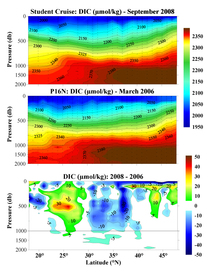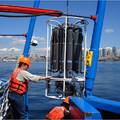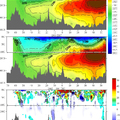Student Cruise 2008
Understanding the North Pacific CO2 sink
The transition region between the subtropical/subpolar N. Pacific (~40º N) is known from global air-sea CO2 flux climatologies to be a large regional sink for CO2 (~0.5 Pg C yr-1 between 14ºN and 50ºN). Here, warm waters of the Kuroshio current cool as they extend into the temperate North Pacific. The resulting increase in CO2 solubility from this cooling results in a net flux of CO2 from the atmosphere into the ocean. This water is subducted and transported equatorward as part of the meridional overturning circulation.
Although this "solubility pump" is an important driving force in ocean CO2 uptake in this region, the production of marine organic carbon (via photosynthesis) and the subsequent export of this organic carbon to depth via the "biological pump" is also thought to be important. One of the major goals of the 2008 Student Cruise, undertaken in collaboration with partners at the University of Washington School of Oceanography , was to quantify the importance of the biological pump to overall carbon uptake in the region, and to better understand the mechanisms regulating this biological carbon flux. To address this question, a suite of biogeochemical parameters were analyzed on this repeat of a CLIVAR hydrographic survey line (P16N) in Aug-September, 2008. Analyses of this data set are ongoing.





